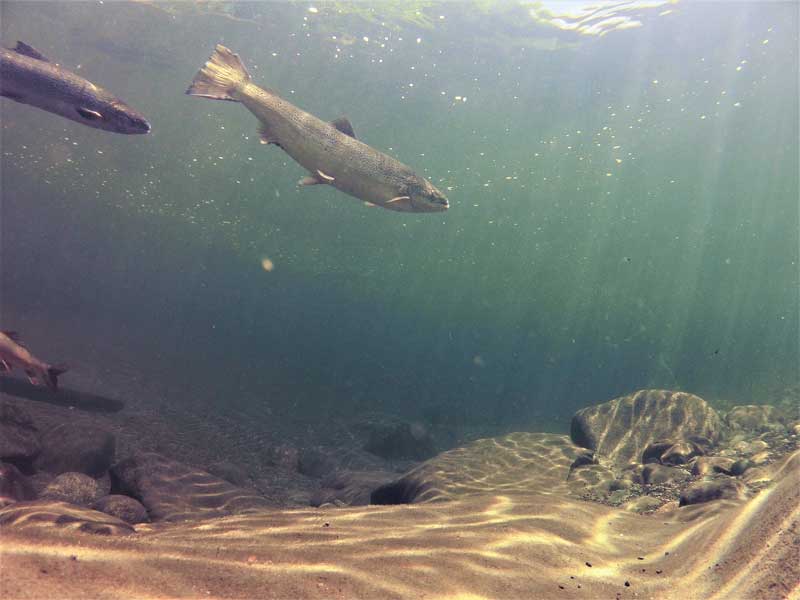 This 3-foot salmon nicknamed Charlie has become a cause célèbre for salmon conservationists who argue that additional measures are critical to restoring wild salmon in the Kennebec River. Photo courtesy Paul Christman/Maine DMR
This 3-foot salmon nicknamed Charlie has become a cause célèbre for salmon conservationists who argue that additional measures are critical to restoring wild salmon in the Kennebec River. Photo courtesy Paul Christman/Maine DMR
In the unorganized western Maine township of East Madrid, cold, clear Perham Stream spills over glacial till through a fertile valley that in the late 1700s supported a vibrant farming community, including the ancestors of Carson Hinckley. A seventh-generation Hinckley, he lives in his family’s early 1800s homestead. The affable, bearded 65-year-old is a local historian and nature buff.
One day last spring, he pointed out to me his hiking trail along Perham Stream, which has become a local birding hotspot. When Hinckley’s ancestors moved to East Madrid from Barnstable, Massachusetts, the stream was a local hotspot for settlers harvesting spawning Atlantic salmon. Carrie Wing Hinckley, Carson’s great-great grandmother, documented the abundant salmon in her diary: “The men,” she wrote in September 1834, “caught four hundred salmon and trout during the weekend.” Hinckley told me, “In the early 1800s, sea-run salmon ascended the Kennebec and Sandy Rivers to Perham Stream. But, because of dams downriver, they haven’t been able to accomplish that feat for nearly two centuries.”
 Maine DMR fisheries biologist Paul Christman releases a wild adult Atlantic salmon in the Sandy River, a tributary of the Kennebec River. It was captured at a fish trap below a dam in Waterville that blocks spawning Kennebec salmon from ascending the river to the Sandy. Photo courtesy Paul Christman/Maine DMR
Maine DMR fisheries biologist Paul Christman releases a wild adult Atlantic salmon in the Sandy River, a tributary of the Kennebec River. It was captured at a fish trap below a dam in Waterville that blocks spawning Kennebec salmon from ascending the river to the Sandy. Photo courtesy Paul Christman/Maine DMR
Long before Hinckley’s ancestors arrived in Perham Valley, the upper Kennebec River teemed with spawning salmon. The Norridgewocks—a band of Wabanaki—annually harvested salmon with spears, traps, and bare hands.
Matt Scott, 88, a retired state fisheries biologist, has studied Maine’s Atlantic Salmon since 1962. “Generations of Native Americans,” he said, “caught hundreds of Kennebec salmon each year at the big eddy below Skowhegan’s Cataract Falls. It was known as the Great Gathering Place because it’s where salmon and Norridgewocks gathered in large numbers.”
When Europeans first arrived in New England, Atlantic salmon were abundant in nearly every river from Labrador to Connecticut. In 1616, explorer Captain John Smith wrote, “on the western shores of the Atlantic, it [salmon] is found from Greenland to the Hudson, but is exceedingly rare in the latter river, and never penetrates farther south.” According to anthropologist Erhardt Rostlund, “There is theoretical reason for thinking that Atlantic salmon, per unit area, was at least as plentiful as Pacific salmon.” Others have disputed Rostlund’s claim, but this much is certain: As a food source, Atlantic salmon were nearly as important as cod to New England colonists.
By the early 1800s, though, river pollution, weir fishing at the mouths of the rivers, and the construction of large dams had caused salmon to vanish in southern New England. When Maine became a state in 1820, salmon remained so abundant that laws were enacted to prohibit fishermen from cleaning fish on public wharves or serving salmon in logging camps more than three times each week. In the Kennebec Valley, tales persist of settlers dumping wheelbarrows of salmon to fertilize potato fields.
Boatloads of salmon—prized in restaurants—were shipped down the Kennebec to markets in Portland, Boston, and New York. However, the construction of Edwards Dam in Augusta in 1837 triggered the end of the great Kennebec River salmon runs. The 917-foot-wide, 24-foot-high dam blocked spawning salmon from reaching shallow gravel-bottom pools, including the one within view of Hinckley’s homestead 110 miles upriver. Four additional Kennebec River hydroelectric dams were soon built between Waterville and Skowhegan to power sawmills, paper mills, cotton mills, and woolen mills.
Today, Maine supports the only wild Atlantic salmon spawning runs in the United States. But even here the “king of fish” is barely surviving as a federally endangered species. A mere 676 adults were counted in Maine rivers in 2021 (25 at Waterville’s Lockwood Dam) and 1,459 in 2022 (82 at Lockwood). Juvenile Atlantic salmon spend two years foraging on capelin in Greenland’s coastal waters before returning to Maine as spawning adults. Among Maine’s few salmon rivers, the upper Kennebec’s cold, spring-fed, well-oxygenated, and treelined tributaries offer the best hope for rebuilding wild salmon populations amid a warming climate. The species’ future, according to biologists, hinges on being able to reach critically important spawning habitat that remains blocked by dams.
“Atlantic salmon are at an inflection point,” said Jennifer Noll, a Kennebec River salmon biologist with the Maine Department of Marine Resources. “Dams, overfishing, warming oceans, pollution and other factors have driven our salmon population to perilously low numbers,” Noll added. “But there’s hope. The 1999 removal of Edwards Dam sparked a resurgence of sea-run fish. Since Edwards removal, three million river herring (alewives and blueback herring) and thousands of shad and striped bass now return annually to the Kennebec. Salmon and sturgeon are also able to swim unimpeded from the ocean to Waterville.”
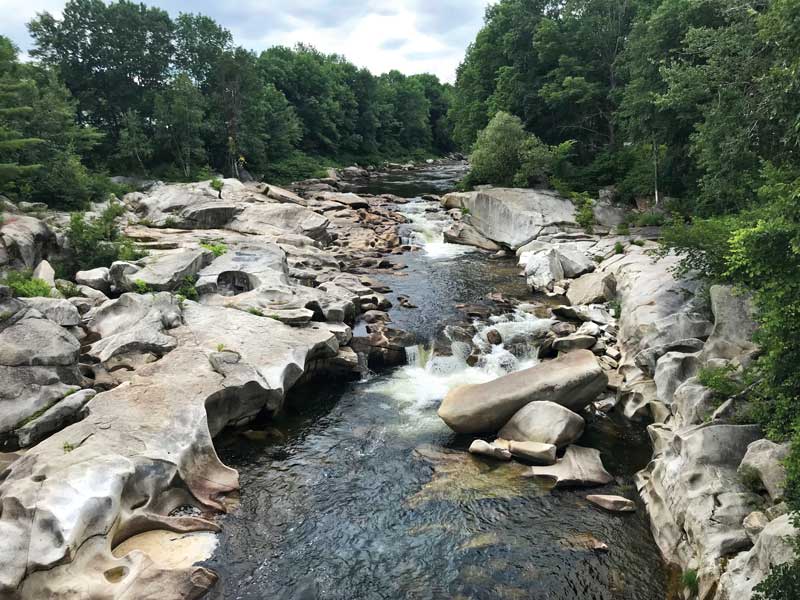 The upper Sandy River, with its deep resting pools and shallow gravel bars bathed with a constant flow of cold water, provides ideal Atlantic salmon egg laying and juvenile salmon rearing habitat. Photo courtesy John Burrows/Atlantic Salmon Federation
The upper Sandy River, with its deep resting pools and shallow gravel bars bathed with a constant flow of cold water, provides ideal Atlantic salmon egg laying and juvenile salmon rearing habitat. Photo courtesy John Burrows/Atlantic Salmon Federation
Currently, migrating adult salmon curtailed by Waterville’s Lockwood Dam are captured in a fish trap and transported upriver past four dams owned by Brookfield Energy, and then released in the Sandy River. The fish taxi service (aka “trap and truck”) is an emergency measure to aid spawning salmon. “We’re essentially applying a life-support system,” said Noll, “to a critically ill wild salmon run until we figure out how to improve fish passage at the four dams between Waterville and Skowhegan.”
The Atlantic Salmon Federation, Maine Rivers, Trout Unlimited, and the Natural Resources Council of Maine are strongly advocating dam removal. Salmon conservationists argue that Brookfield Energy’s contribution to the state’s electrical grid—less than three percent—can be replaced by solar and wind power. But Brookfield Energy remains opposed to dam removal. Instead, they have proposed measures to improve fish passage through the dams. Company officials did not return phone calls asking for comment.
On Maine’s Penobscot River, dam removals have proven to be a boon to salmon. The river now supports the largest Atlantic salmon spawning runs in the country. The takeaway message is clear: dam removal is our best option to restore salmon and other anadromous fishes to Maine’s rivers.
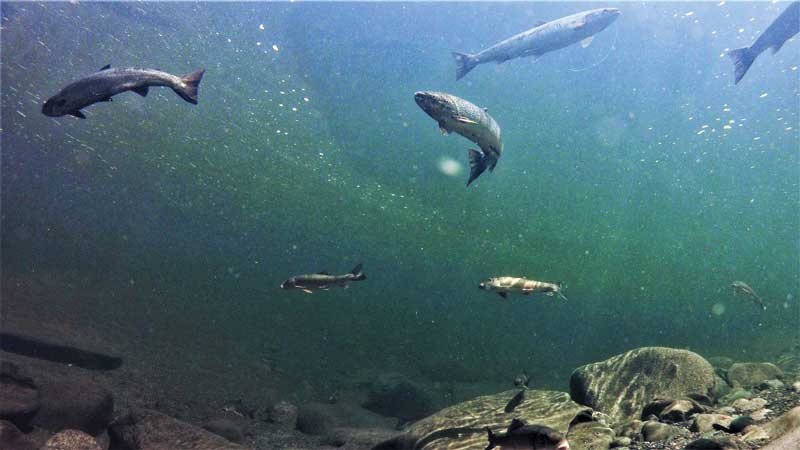 For eons, prior to dams, adult Atlantic salmon migrated unimpeded two thousand miles from Greenland to the upper headwaters of Maine rivers to spawn in the waters of their birth four years earlier. Photo courtesy Paul Christman
For eons, prior to dams, adult Atlantic salmon migrated unimpeded two thousand miles from Greenland to the upper headwaters of Maine rivers to spawn in the waters of their birth four years earlier. Photo courtesy Paul Christman
Noll’s passion for salmon began in childhood at her parents’ camp near Moosehead Lake. “My dad often took me fishing,” she said, while moving a 32-inch salmon from Brookfield’s fish lift into her pickup truck’s water tank. “Our camp wall is adorned with faded photos of beautiful brook trout and salmon my dad caught as a kid. It bothered me that I’d never have the same experience of catching large salmonids. I knew at a very young age that I wanted to help restore salmon and trout.”
Beginning in 2011, Noll has transported dozens of adult salmon upriver, but one stands out as exceptional. “He’s a 3-foot salmon nicknamed Charlie,” she said, “and is implanted with a passive integrated transponder tag."
A repeat spawner, Charlie, age 6, has completed several round trips from Greenland to Maine. “Maine’s salmon smolts (juveniles) implanted with tags have been detected along the west coast of Greenland and above the Arctic circle,” said Paul Christman, Maine DMR marine biologist. Tags help biologists track migrating salmon.
Although salmon are great leapers, Charlie couldn’t surmount the 17-foot-high concrete dam. Returning Maine salmon have successfully battled warming oceans, commercial fishing nets, hungry seals, predatory fishes, eagles, and injuries to reach Waterville, where their journeys from Greenland are thwarted by dams.
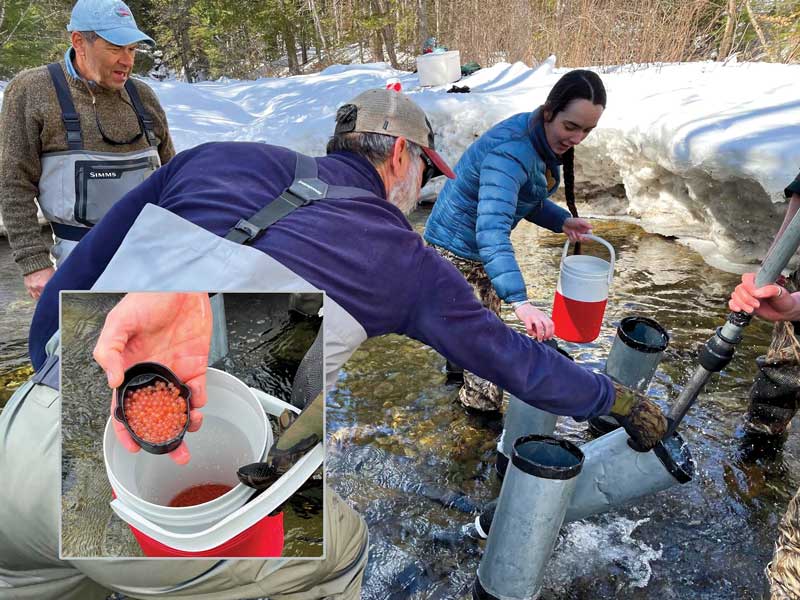 With so few wild spawning adult salmon able to reach the upper Kennebec River watershed, biologists and volunteers augment salmon reproduction by annually depositing thousands of fertilized pink salmon eggs in artificial redds (salmon nests) excavated by portable water pumps. Photos courtesy Ron Joseph
With so few wild spawning adult salmon able to reach the upper Kennebec River watershed, biologists and volunteers augment salmon reproduction by annually depositing thousands of fertilized pink salmon eggs in artificial redds (salmon nests) excavated by portable water pumps. Photos courtesy Ron Joseph
In his six decades as a fisheries biologist, Matt Scott has accumulated a wealth of Atlantic salmon knowledge. “I worked on the Kennebec River in the early 1960s when it was terribly polluted by mills and raw sewerage,” he said. “Now that the river is clean again, we need to provide salmon and other sea-run fish access to their historic spawning habitat. Removing antiquated dams that block their way upriver is long overdue. The fish will take care of themselves if allowed to swim freely upriver.”
Beginning in 2012, to augment the small spawning salmon run in the lower Kennebec River, Noll and a dozen volunteers planted thousands of fertilized pink salmon eggs in the upper Kennebec’s tributaries, including Perham Stream. Since then, Noll’s total yearly plantings is approximately 700,000, most of which are from Penobscot River salmon spawned at Green Lake National Fish Hatchery near Ellsworth. Charlie hatched from one of those eggs or from an egg of a wild salmon trapped and trucked upriver from Lockwood dam.
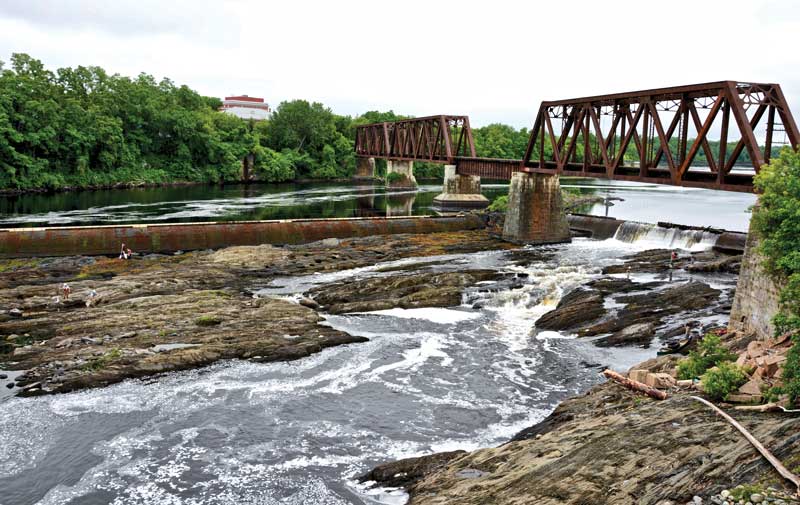 The Lockwood Dam in Waterville is the first of four dams hindering spawning Atlantic salmon from accessing the Sandy River and other Kennebec River headwater tributaries. Since the 1999 removal of the Edwards Dam in Augusta, salmon are able to swim freely from the ocean to Waterville. Photo courtesy John Burrows
The Lockwood Dam in Waterville is the first of four dams hindering spawning Atlantic salmon from accessing the Sandy River and other Kennebec River headwater tributaries. Since the 1999 removal of the Edwards Dam in Augusta, salmon are able to swim freely from the ocean to Waterville. Photo courtesy John Burrows
“I’d like to live long enough,” said Hinckley, “to witness the return of schools of spawning salmon in Perham Stream, even if the runs are shy of ones my great-great grandmother documented in her diaries. I’m hopeful because Jennifer Noll has planted thousands of salmon eggs within sight of my farmhouse.”
French writer Louis Charbonneau-Lassay, author of the 1949 book, The Bestiary of Christ, wrote, “The egg contains a promise.” The meaning of Charbonneau-Lassay’s sentence is not lost on Noll, who has planted more Atlantic salmon eggs than any North American fisheries biologist. In March 2022, during the season’s final egg planting trip, I accidentally spilled a few dozen fertilized salmon eggs onto her truck’s tailgate. “Oh no,” Noll groaned, scrambling to help me collect the eggs. “If any of these eggs are lost, I’ll feel worse than when I lost my wedding ring.”
✮
Writer Ronald Joseph, author of the memoir Bald Eagles, Bear Cubs, and Hermit Bill, is a retired Maine wildlife biologist. He lives in central Maine.






